The Essence of Light: Best Wall LED Lights
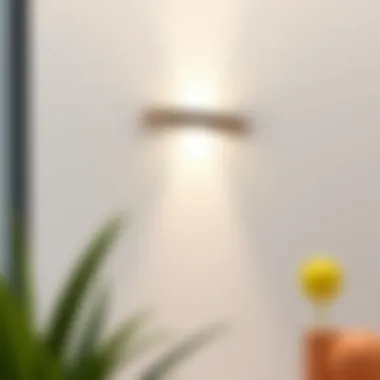
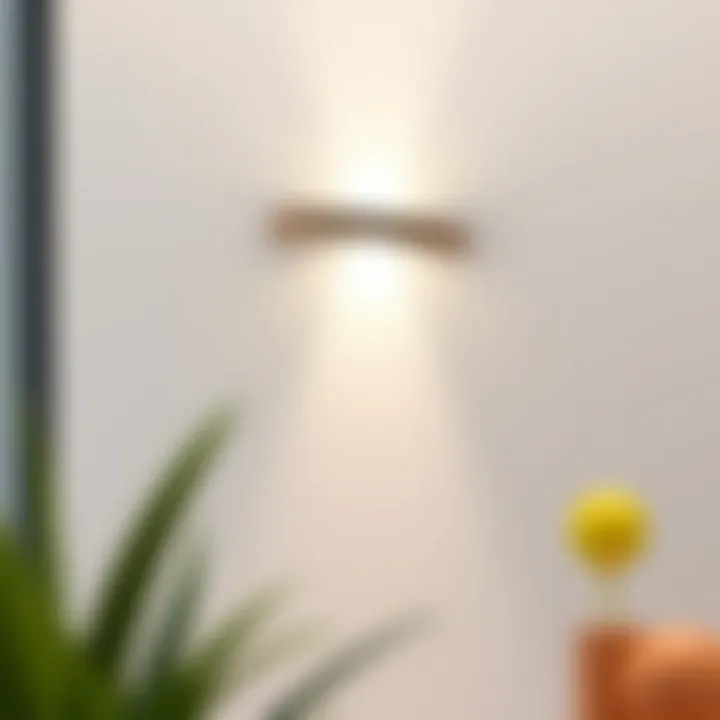
Intro
In our ever-evolving quest for effective and aesthetic lighting solutions, wall LED lights have emerged as a game changer. Gone are the days when illumination was merely about functionality—today, it is as much about style and energy efficiency. Whether one is a designer looking to set the mood in a chic cafe or a homeowner aiming to enhance comfort at home, understanding the core principles behind wall LED lighting can make all the difference.
This guide endeavors to demystify wall LED lights, exploring their myriad styles, designs, and functionalities. We'll touch on the technology powering these lights, their impact on environment, and how choosing the right type can transform a space. Beyond that, there will be practical insights to assist in selecting the appropriate fixtures, installation techniques, and maintenance strategies.
Engaging with this topic is essential not just for personal spaces, but also for professional environments where lighting plays a key role in mood and productivity. Let’s embark on this illuminating journey into the essence of wall LED lights.
Furniture Design Insights
Understanding Style Preferences
When considering wall LED lights, a designer's or homeowner's style preference is paramount. Different settings ask for different aesthetics; a sleek, modern design may suit a minimalist apartment, while warmer, more intricate designs might enhance a vintage-inspired living room. Think about how the light fixtures harmonize with existing furniture and decor.
Here are a few popular styles:
- Contemporary: Clean lines, often with a metallic finish.
- Industrial: Incorporates raw materials and a rugged look, best for loft settings.
- Vintage: Wrought iron or brass, evoking a nostalgic charm.
- Sculptural: Artistic designs that function also as decor.
A well-chosen light fixture can act as a focal point, drawing the eye and adding dimension to a room.
Maximizing Space with Smart Layouts
Incorporating wall LED lights into a well-thought-out layout can do wonders for spatial dynamics. For smaller rooms, lights placed strategically can create the illusion of depth and space. Here are some approaches:
- Elevating Entry Spaces: Utilize wall sconces at eye level to create a welcoming atmosphere.
- Illuminating Pathways: Position lights along hallways to guide movement and enhance safety.
- Accent Lighting: Highlight art pieces or architectural features to bring character to otherwise flat areas.
Lighting isn't merely a functional necessity; when applied creatively, it transforms the overall feel of a space.
Maintenance and Care Tips
Cleaning Techniques for Different Materials
Maintaining the appeal of wall LED lights demands a bit of diligence. Different finishes and materials call for unique cleaning methods. For example:
- Metal finishes: Use a soft cloth dampened with water to remove dust and a mild soap solution if necessary.
- Glass shades: A mixture of vinegar and water can work wonders without scratching.
- Wooden fixtures: Gentle dusting followed by a wood-specific cleaner will preserve their luster.
Regular maintenance ensures not only longevity but also retains the designed ambiance of the lighting.
Preventative Measures Against Wear and Tear
Keeping your LED lights functional isn’t just about cleaning; it’s also about how they’re used. Here are some preventative measures:
- Avoid Overheating: Ensure fixtures are assigned their proper wattage to avoid wear.
- Check Installations: Regularly inspect for any issues with wiring to prevent short circuits.
- Use Dimmers: These help in extending the life of your LED lights while allowing for adjustable brightness.
Taking time for regular upkeep is well worth the effort; it prevents the hassle of replacements and keeps your spaces shining bright.
Prologue to Wall LED Lights
In the modern age, wall LED lights have become an essential fixture in both residential and commercial spaces. They are more than just sources of illumination; they serve as accent pieces, setting the mood and enhancing the aesthetics of a room. Understanding the significance of wall LED lights is crucial for designers, retailers, homeowners, and DIY enthusiasts alike.
There’s a reason these lighting solutions are gaining traction. Not only do they come in a variety of styles — from sleek sconces to versatile strip lights — but they also offer an energy-efficient alternative to traditional lighting options. A primary consideration for many is sustainability. Wall LED lights consume significantly less power compared to incandescent bulbs, leading to lower electricity bills over time. This reduction in energy consumption is a win-win, both for your wallet and the environment.
Furthermore, when discussing wall LED lights, one cannot ignore the technological advancements that have accompanied their rise. Modern LED lights can be integrated with smart technologies, allowing for programmable settings that enhance convenience. With the ability to adjust brightness or color temperatures with a few taps on a smartphone, users can create personalized lighting experiences that align with their preferences.
Decor plays a crucial role, as well. By selecting wall LED lights that complement existing decor, one can create a cohesive atmosphere throughout the space. Whether you choose a modern design or a more traditional look, there’s a wall LED light to match every style.
Here's an important point to consider:
"The right lighting can transform an ordinary room into an extraordinary space. A well-placed wall LED light can highlight artwork or architectural details, creating visual interest and depth."
In summary, wall LED lights are pivotal in enhancing both functionality and style in various settings. For anyone looking to improve their space, understanding these lights and their myriad benefits is a step in the right direction. From energy savings to aesthetic enhancements, the exploration of wall LED lights is not just valuable but essential in today’s lighting landscape.
Understanding LED Technology
When it comes to wall LED lights, understanding the underlying technology is pivotal. This knowledge doesn't just enhance your appreciation of these lighting solutions, but it also helps in making informed decisions about design and functionality. LED technology, or Light Emitting Diode technology, has rapidly evolved and transformed the way we think about and utilize lighting in both residential and commercial spaces. It offers a myriad of options for style and efficiency while being highly adaptable to various environments.
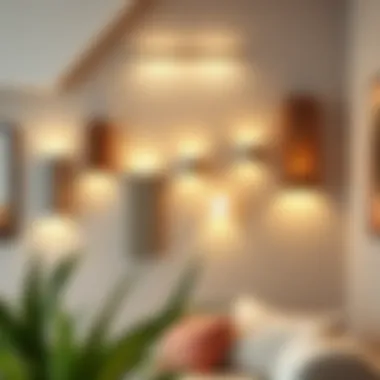
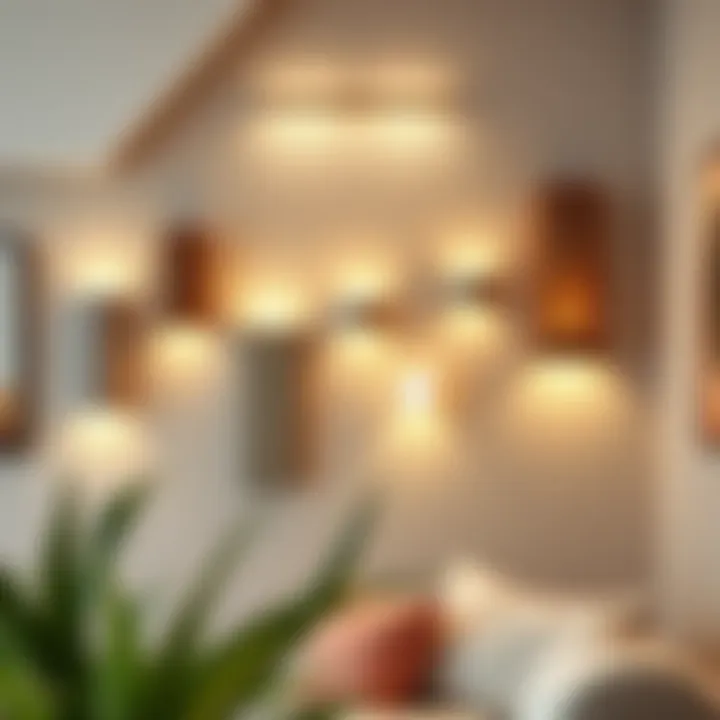
How LEDs Work
LEDs are unique little devices that produce light through the movement of electrons in a semiconductor material. Unlike traditional bulbs that rely on heating a filament or gas, LEDs emit light when an electric current passes through them, exciting the electrons and causing them to jump to a higher energy state. When they fall back to their original state, they release energy in the form of light.
This process is known as electroluminescence. The intrinsic properties of LEDs allow them to work efficiently, producing a bright light with minimal energy loss in the form of heat. That's why an LED light can be both energy-efficient and long-lasting. The lifespan of LED lights is significantly longer than traditional incandescent bulbs, often lasting up to 25,000 hours or more. This longevity makes them an attractive choice for homeowners looking to reduce replacement costs.
Benefits of LED Lighting
The advantages of incorporating LED technology into your lighting design cannot be overstated. Here are a few notable benefits:
- Energy Efficiency: One of the biggest draws of LEDs is their incredible efficiency. They consume considerably less power than traditional lighting options, translating to lower electricity bills over time.
- Durability and Longevity: They're built tough, often resistant to shock and vibrations. This durability means that if a bulb does go out, it's typically only a small fraction of the total lighting solutions that need replacement, maximizing overall lifespan.
- Low Heat Emission: Since LEDs generate minimal heat compared to conventional bulbs, they contribute less to heat buildup in a room. This quality can be particularly advantageous in smaller spaces or during hotter months, where managing room temperature is crucial.
- Variety of Color Temperatures: LEDs are versatile in their color outputs. From warm white to cool white, you can create the specific ambiance you desire, whether for a cozy living room or a modern workspace.
"Investing in LED lighting isn’t just a trend; it’s a shift toward more sustainable and cost-effective solutions for illuminating our lives."
- Environmental Benefits: Because they consume less energy, they also contribute to a decrease in carbon emissions when powered by fossil fuels. Using energy-efficient lighting like LEDs is an impactful choice towards achieving sustainability in your home or business.
To sum it up, understanding LED technology opens up a world of potential for excellent lighting solutions, aligning with the priorities of modern design—efficiency, style, and sustainability.
Types of Wall LED Lights
When delving into the realm of wall LED lights, understanding the different types available is pivotal. Each has its unique allure and function, catering to diverse styles and needs in both residential and commercial settings. By dissecting the various forms of wall LED lighting, individuals can make more informed choices that align with their aesthetic preferences and functional requirements. Knowing the distinctions helps avoid a mismatched decor, ensuring a harmonious blend in any space.
Wall Sconces
Wall sconces are more than just functional; they serve as a central piece of a room's decor. Typically mounted on walls, these fixtures can offer both upward and downward illumination and may be used to highlight artwork or architectural features. In places like hallways or beside mirrors, they can create a welcoming glow, enhancing visibility while adding depth to the design.
Sconces can vary widely in design; think ornate vintage styles juxtaposed with sleek, modern pieces. Installing them not only introduces light; it injects personality into the space. Their versatility allows for either a dramatic statement or subdued ambient lighting, catering to every taste. It's worth remembering that the height at which wall sconces are mounted can significantly affect the overall feel of the room.
LED Strip Lights
LED strip lights are among the most adaptable lighting options available today. These flexible strips can be adhered to almost any surface, from ceilings to shelves, allowing for creative arrangements and innovative designs. Their configuration typically comes in rolls, giving users the liberty to cut them to their desired lengths.
One of the most appealing aspects of LED strip lights is their ability to provide ambient lighting without overpowering the space. They are ideal for accentuating architectural features or creating subtle illumination in tight spaces. The range of available colors and brightness levels allows for mood-setting in various environments. However, careful planning is needed to ensure that the light emitted complements the space’s overall aesthetic.
Panel Lights
Panel lights offer a sleek, modern solution for areas that require bright, direct illumination. Often found in offices and commercial buildings, these lights provide a minimalist look that can seamlessly blend with different décors. They are designed to fit into modular ceilings or can be mounted directly onto walls for added versatility.
Panels come in various shapes and sizes, usually orienting light uniformly across a broad area. This makes them not only practical but also visually pleasing. The energy efficiency of panel lights also contributes to their popularity, as they consume less power compared to traditional fluorescent lights while delivering greater lumen output. Proper placement can make a significant difference in how well these lights function and enhance the environment.
Recessed Lights
Recessed lights are perfect for those seeking a clean, unobtrusive look in their lighting design. Installed within the ceiling, these fixtures create an illusion of spaciousness, drawing the eye upward while providing functional lighting. Often used in living rooms, kitchens, and even bathrooms, they offer an effective way to illuminate a space without taking up physical visual space.
While they can be installed to provide general overhead lighting, many choose to incorporate them into layered lighting schemes. Track lighting can also include recessed options, offering flexibility in terms of directing light where needed. However, thorough planning regarding spacing and placement is essential, as poor execution can lead to an uneven distribution of light and shadows, which might not be ideal for your space.
"The choice of wall LED lights not only influences the practicality of lighting but also shapes the very essence of your space's ambiance."
Each type of wall LED light has its merits and ideal environments. As this discussion unfolds, consider how these different styles fit into your vision, and remember to pay careful attention to configurations to maximize their impact.
Design Considerations
Design considerations play a pivotal role when integrating wall LED lights into any space. The right lighting not only enhances aesthetics but also significantly influences functionality and ambiance. Whether you're a designer, retailer, homeowner, or DIY enthusiast, understanding these elements aids in crafting a space that marries beauty with practicality. This section examines the crucial aspects of style compatibility, color temperature, and brightness levels—three key components that guide the selection of wall LED lights.
Style Compatibility
Choosing wall LED lights that align with a room's existing decor is fundamental. An incongruous fixture can disrupt the visual harmony, making it essential to consider the overall style of your space. For instance, a rustic farmhouse may benefit from warm-hued sconces that evoke a sense of coziness, while a sleek contemporary room shines with minimalist fixtures that boast geometric lines.
When thinking about style compatibility, consider:
- Material: Metal finishes like brass or chrome can influence the style narrative.
- Shape and Size: Larger fixtures work well in grand spaces, while intimate areas may call for more delicate designs.
- Color Schemes: Match or contrast colors effectively to enhance visual interest.
By harmonizing the fixtures with the existing decor, you create an environment where lighting complements rather than competes with other design elements.
Color Temperature
Color temperature is another essential factor that impacts not just the look but also the feel of a space. Measured in Kelvins (K), color temperatures can be classified into warm and cool tones. Understanding the implications of different temperatures can help you set the desired mood effectively.


- Warm Light (2700K - 3000K): This range is often associated with a soft, inviting atmosphere, ideal for living spaces and bedrooms. Think of cozy evenings spent reading on a couch surrounded by warm light.
- Cool Light (4000K - 5000K): Often preferred for kitchens and offices, cool light mimics daylight, which can enhance focus and activity. It's useful for task lighting where concentration is paramount.
Practical Applications
When it comes to illuminating a space, wall LED lights serve a versatile role that transcends mere aesthetics. They are not only about adding flare but also about enhancing the usability of different environments. Understanding the practical applications of wall LED lighting can significantly influence how we approach design and functionality in both residential and commercial settings.
In residential spaces, wall LED lights improve the ambiance and make everyday tasks easier, while in commercial areas, they play a role in branding and creating welcoming environments. Here’s a closer look at how these lights are put to use.
Residential Use
In the home, wall LED lights can create mood and functionality. They can be used for diverse purposes – from accentuating architectural features to providing task lighting in specific areas. It's not just about light; it's about how it influences your experience at home.
- Ambient Lighting: Wall sconces can cast a soft glow in hallways or living rooms, creating a calming atmosphere. This subtle lighting helps in establishing the mood for relaxation or social gatherings.
- Task Lighting: Placing LED strip lights under cabinets or in bookshelves is perfect for reading or cooking. Properly focused light can reduce eye strain and make every task a breeze.
- Accent Lighting: Highlighting artwork or family photos is common with recessed lights or wall-mounted fixtures, bringing life to dull walls and showcasing personal stories.
- Night Lights: Gentle, low-brightness LED lights can guide your way during the wee hours, ensuring safety without being disruptive.
Designers often recommend using a mix of these lighting styles to create layers of light, making spaces feel more inviting and functional.
Commercial Use
For businesses, the strategic use of wall LED lights can influence customer behavior and shape perceptions of a brand. Well-thought-out lighting enhances the environment, making it more appealing.
- Brand Identity: Certain colors and designs in wall lighting can complement a brand’s visual identity. For instance, a chic boutique might use sleek sconces to enhance an upscale feel, while a café might opt for warm, inviting lights to create a cozy atmosphere.
- Functional Spaces: In offices, wall lights can improve visibility without causing glare on screens. They can illuminate workspaces effectively, meeting the needs of both employees and clients.
- Safety and Security: Good lighting is often an overlooked aspect of safety. Bright, well-placed wall LEDs can deter unwanted behaviors in commercial areas, ensuring safety for patrons and staff.
- Showcase Products: Retail spaces can use wall LED lights to spotlight merchandise, inviting attention and boosting sales.
As seen, wall LED lights are pivotal in enhancing both the residential and commercial experiences, shaping not only how spaces look but also how they function. Whether it's setting the mood at home or projecting a brand image in a store, understanding these practical applications provides insight into the overall impact of effective lighting.
Energy Efficiency and Sustainability
In an age where energy consumption and environmental impact are at the forefront of global discussions, the significance of energy efficiency and sustainability in lighting cannot be overstated. Wall LED lights not only offer aesthetic appeal but also embody the notion of responsible energy use. Choosing LED over traditional lighting solutions means you're opting for a technology that uses less power while delivering the same brightness. This aspect alone is a game-changer for both household budgeting and the environment.
Integrating energy-efficient lighting into living or working spaces often leads to tangible cost savings. With advances in LED technology, these lights not only consume significantly less electricity, their lifespan is also markedly longer than conventional bulbs. This means fewer replacements and less waste, assisting in the broader mission of sustainability.
Long-term Cost Savings
When considering the financial benefits of switching to LED wall lights, understanding the long-term cost savings is crucial. The upfront cost of LEDs might seem higher, but this investment pays off in spades over time. On average, LED bulbs can last up to 25,000 hours, compared to just 1,000 hours for incandescent bulbs. Therefore, if you consider the replacement costs and energy bills associated with traditional bulbs, the savings pile up considerably.
A simple calculation can highlight this:
- Initial cost of incandescent bulbs is typically lower, but they consume up to 80% more energy while in use.
- LED lights, while pricier initially, use at least 75% less energy and have a longer lifespan.
Thus, in a household that replaces just ten bulbs, moving to LED could save up to $200-$300 over a decade in energy costs—money that can be better spent elsewhere.
Additionally, many utility companies offer rebates for switching to energy-efficient lighting, further reducing the payback period of this switch.
Environmental Impact
Shifting to LED technology isn't purely about cost savings. The environmental impact of lighting choices weighs heavily in today’s consumer decisions. LED lights contribute to reducing the carbon footprint significantly. Since LED lights consume less energy, they naturally decrease the demand for electricity, which in most areas is still derived from fossil fuels. This change positively influences air quality and contributes to a more sustainable future.
Moreover, LEDs are free from harmful chemicals such as mercury, which is commonly found in fluorescent bulbs. As a result, when LEDs end their long service life, they present less of a disposal concern. With electronics recycling programs becoming more common, it is easier than ever to ensure that old systems are disposed of correctly.
"The transition to LED lighting is not just about modern aesthetics; it’s a path toward eco-conscious living and responsible energy use."
In summary, the energy efficiency and sustainability of wall LED lights are paramount not only for long-term financial savings but also for making a significant environmental impact. Embracing these lights aligns with a growing commitment to sustainability, making it a win-win for both consumers and the planet.
Installation Tips
When it comes to enhancing your living or working space with wall LED lights, installation is a crucial piece of the puzzle. Choosing the right wall lights isn’t just about aesthetics; it’s also about functionality and safety. Not only does a proper installation maximize the effectiveness of your lighting, but it also contributes to the longevity of the fixtures and can significantly impact your overall satisfaction with the setup.
One must consider several factors when diving into the nitty-gritty of installation. For instance, where the lights will be positioned can make all the difference in how a room feels and functions. An improper install can lead to shadows or harsh glares, affecting readability and ambiance. Moreover, the accessibility for future maintenance can’t be ignored.
Selecting Locations
Selecting locations for your wall LED lights involves a thoughtful approach. Consider, first and foremost, the purpose of the lighting.
- In living rooms, a soft glow can create a relaxed atmosphere or highlight artwork.
- In kitchens or workspaces, brighter light can aid in tasks such as food prep or project work.
Moreover, the height at which the lights are installed plays a significant role. For instance, mounting wall sconces at eye-level can create a warm, inviting look, while higher placements can give an interesting upward light effect without being too bright.
Key considerations:
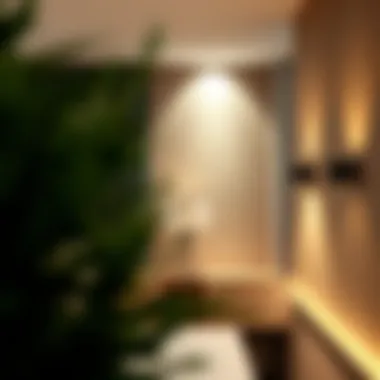

- Room Size: Larger spaces may require multiple light sources to achieve even illumination.
- Existing Fixtures: Consider how new lights will interact with ceiling fixtures or natural light sources.
- Traffic Flow: Avoid placing lights in areas that may create hazards or obstructions.
It's important to envision the everyday usage of the space and how the lighting interacts with activities taking place.
DIY Installation vs. Professional Help
The choice between DIY installation and hiring a professional can be a head-scratcher. Go the DIY route if you have a knack for home projects and are comfortable with basic wiring tasks. It can save you some bucks, and let’s face it, there’s a certain satisfaction in standing back to admire your handiwork. However, keep in mind that wiring can be tricky, and one wrong move can lead to mischief with your home’s electrical system.
On the other hand, bringing in a professional can ease those worries. A skilled electrician can both save you time and ensure that the installation is done with safety as the top priority. They can also offer advice on optimizing your layout and lighting choice for your specific needs, which is invaluable, especially for those looking to create specific atmospheres in a space.
"The right lighting can change not just how a room looks, but how it feels to be in it. Making the right decisions during installation can lead to a significant enhancement in ambiance and functionality."
Ultimately, the decision hinges on your skill set, budget, and the complexity of the installation. If it’s likely to be a straightforward job, roll up your sleeves. If it seems daunting, don’t hesitate to call in the experts.
Maintenance and Care
Keeping wall LED lights in top condition not only extends their lifespan but also ensures they perform effectively in enhancing your environment. Regular maintenance can prevent issues that may arise from dust accumulation, improper placement, or components wearing out. This section explores essential cleaning techniques and common issues that could impact the functionality and aesthetics of wall LED lights.
Cleaning Techniques
Fostering a clean and dust-free environment for your wall LED lights is crucial. Regular cleaning helps maintain their brightness and efficiency. Here are some effective techniques for cleaning your LED lights:
- Duster or Soft Cloth: For most wall sconces or fixtures, a simple duster or microfiber cloth can work wonders. Just gently wipe the surfaces to remove dust.
- Mild Soap Solution: For tougher grime, mix a few drops of mild soap with warm water. Dampen a cloth with the solution and wipe the fixtures, avoiding any saturation that may cause damage.
- Compressed Air: Using compressed air can clear out hard-to-reach areas, particularly in intricate light designs. Just make sure to do this outdoors or in a well-ventilated area.
- Avoid Abrasives: It’s essential to steer clear of harsh chemicals and abrasive materials that can scratch surfaces or damage finishes. Stick with soft tools to keep your lights looking their best.
Regular maintenance is crucial in keeping your LED wall lights shining bright and saving you money in the long run.
Addressing Common Issues
Every now and then, wall LED lights might face some hiccups. Being aware of potential problems allows for swift resolutions and keeps your lighting upfront and functional. Here are some common issues and how to tackle them:
- Flickering Lights: Flickering can stem from loose connections or a faulty bulb. Ensure that all connections are tight and that the bulb is secure. Replacing the bulb may be necessary if the problem persists.
- Color Inconsistency: Sometimes, different panels or bulbs may emit varied hues of light. This might be due to using products from different brands, so try to match components when replacing.
- Overheating: If you notice excessive heat coming from your fixtures, it might indicate inadequate ventilation or a potential failure in the LED driver. Regular inspection can prevent this issue, ensuring elements are properly ventilated.
- Dim or Dead Bulbs: If a wall LED light is dimming or has gone out, verify the power source first. If everything is in order, the bulb likely needs replacing.
- Corrosion or Discoloration: If your lights are exposed to moisture, it may lead to corrosion. Ensure proper sealing and use lights rated for bathroom or outdoor usage where needed. Keeping connectors dry will also mitigate this risk.
By addressing these issues promptly and observing regular cleaning practices, your wall LED lights can maintain their brilliance over time, enhancing the overall atmosphere of your spaces. Designers, retailers, and DIYers alike will find that a little vigilance goes a long way in preserving the aesthetics and function of their lighting choices.
For further reading on LED technology and maintenance, you can explore resources such as Wikipedia or Britannica.
Future Trends in LED Lighting
As we steadily march into a more advanced era, the evolution of wall LED lighting resonates with the dynamics of both technology and design. This section will delve into the current trends shaping LED lighting and its implications for the market. With a focus on innovation and sustainability, understanding these trends not only enhances aesthetic appeal but also aligns with energy efficiency considerations.
Smart Lighting
In the age of connectivity, smart lighting has emerged as a game-changer. Integrating technology into everyday lighting systems allows for unprecedented control and customization. Homeowners and designers now enjoy the flexibility to create settings that reflect mood or optimize energy use through smartphone apps or voice commands.
- Energy Management: Smart LED lights can adapt their brightness based on natural light available, thus reducing unnecessary energy expenditure. This adaptability promotes not just cost savings but a sustainable approach to energy consumption.
- Home Automation: Integrating LED lights into smart home systems enhances convenience. Lights can be programmed to turn on or off at specific times or adjusted remotely, offering both security and ease of living.
"The future of lighting isn’t just in seeing; it’s in experiencing, with each light telling a story about efficiency and comfort."
However, the implementation of such technologies doesn’t come without its challenges. Data security in connected devices—especially in shared or public spaces—needs thorough consideration. For designers and homeowners alike, staying informed about technology upgrades and compatibility is crucial for maximizing the benefits of smart lighting systems.
Innovations in Design
Innovations in design are transforming how we perceive and utilize wall LED lights. As traditional forms give way to more creative expressions, we see a blend of aesthetics and functionality taking center stage. Such advancements pave the way for more personalized spaces and unique experiences through light.
- Sculptural Forms: Walls are no longer merely a backdrop. Designers are crafting LED lights that serve as art pieces, thus reimagining how light interacts with space. The juxtaposition of light and shadow creates depth and adds a layer of intrigue to interiors.
- Color-Changing Capabilities: The ability to alter the hue of light according to preference or activity lends versatility to design. Whether for a home theater experience with warmer tones or a bright, energizing blue for a productivity nook, the options empower users to curate their ambiance.
- Minimalism: In contrast, there's a growing inclination toward clean lines and unobtrusive designs that complement rather than dominate a space. This trend speaks to modern sensibilities where simplicity and elegance enhance functional areas without cluttering.
Staying ahead in trends requires constant awareness. Designers, retailers, and homeowners should keep a pulse on marketplace shifts and emerging technologies. Engaging with resources such as Wikipedia or participating in forums like Reddit can offer valuable insights and community feedback.
In summary, exploring the future trends in LED lighting reveals opportunities for growth and adaptation. By embracing smart technologies and innovative designs, stakeholders in this space can not only enhance their environments but also contribute to a sustainable future.
Closure
In wrapping up our exploration of wall LED lights, it's vital to recognize how these lighting solutions do more than just brighten up a space. They influence mood, enhance design, and play a crucial role in energy consumption and sustainability. The transition to LED lighting has been a game-changer, offering an eco-friendly alternative that doesn't skimp on performance or aesthetics.
When choosing wall LED lights, understanding the various types and their functions is essential. From wall sconces that create cozy nooks to strip lights that offer versatile applications in both homes and commercial spaces, the options are vast and customizable. Designers and homeowners alike can benefit from tailored solutions that match their specific needs—whether it's showcasing artwork or providing task lighting in a workspace.
A noteworthy element of our investigation is how these lights contribute to energy efficiency. By consuming less power and offering longer lifespans, wall LED lights are not just cost-effective; they also reduce the ecological footprint. This makes them an attractive choice for the environmentally conscious, aligning with modern sustainability goals.
Furthermore, the insights into installation and maintenance impart a sense of practicality. Both DIYers and professionals can appreciate the straightforward approach to integrating LED lights into existing spaces. Regular care and a few simple cleaning techniques can keep these fixtures glowing brightly for years to come.
Ultimately, making informed decisions about wall LED lights can transform a mundane setting into a beautifully lit environment. Whether you’re renovating a home or outfitting a new office, attention to detail in lighting choice is paramount. The right wall LED lights not only fulfill a function but also elevate an atmosphere, making it a crucial consideration for anyone involved in design or decor.
In summary, wall LED lights are more than just a trend; they are a fundamental aspect of modern design and functionality. As we continue to advance into a future where energy efficiency reigns, these lighting solutions are sure to illuminate spaces—and perspectives—for years to come.















